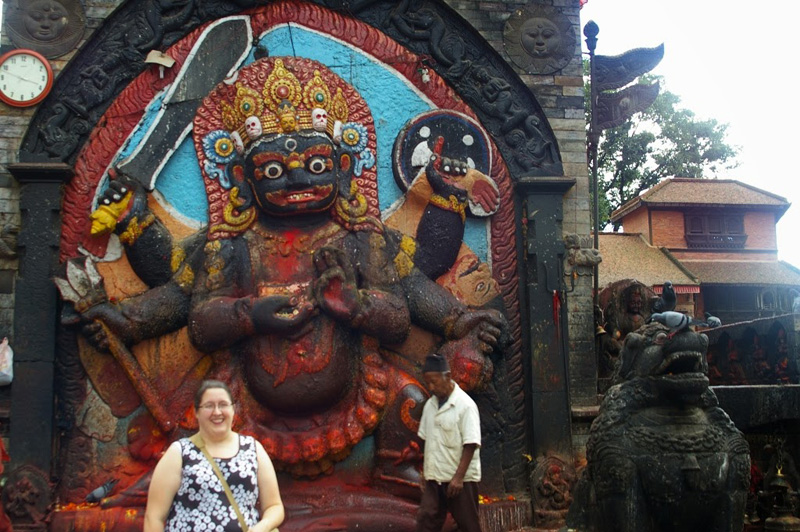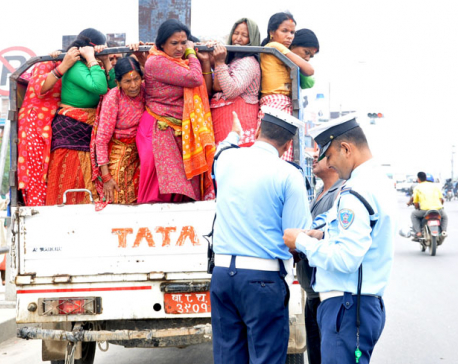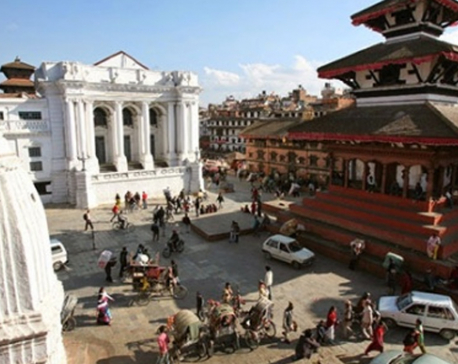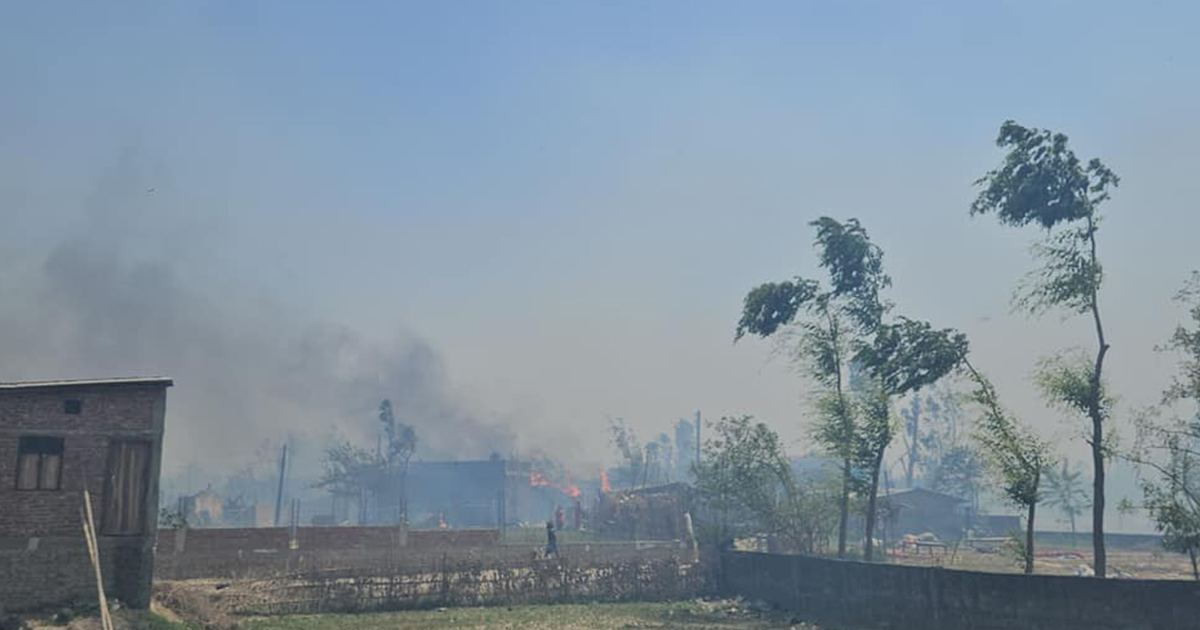
OR

It was believed that the suspects would vomit blood and die on the spot if they lied before Kal Bhairav
The Basantapur Durbar Square has been my favorite hangout since childhood. It is one of the places in Nepal where divinity mingles with humanity, draws foreign money and gives a boost to the national economy.
The square, a tourist hub in the 80’s too, is where my struggle with broken English began. Perhaps Akash Bhairhav, Kal Bhairav, Guru Gorakhnath, Hanuman, Shiva-Parvati duo, Maru Ganesh and Garuda waiting for Lord Vishnu’s orders used to smile (fearful that a hearty laugh would scare away the tourists and deal a blow to the national economy!) at my desperate effort to drive the point home that I actually can utter a few English words.
That struggle continues with many larger than life figures of this day and age, with their English far more polished than mine. Many of the modern landmarks that dot the area were not there during those times. Himalayan Java was obviously not there. But most of the ancient heritages like the Kashthamandap Temple and Maju Dega were in fine fettle.
Natraj Travels and Tours was there, so was the Dairy Development Corporation’s ice-cream parlor, Bishal Bazaar (it was the only supermarket in Kathmandu and we children used to go there for escalator rides, if not for shopping) and so were curio shops selling trinkets to expensive stuffs like gems and singing bowls (in a conversation on May 19, some curio shop owners said they inherited those shops from their grandfathers).
Hotel Sugat was there, the labyrinthine gullies were there and so were small shops selling very many stuffs made mainly of Thulo Khasi (buffalo), back then too. Me and my sister, who spent most of our childhood in rented accommodations in Gwachhemugal, Maru and Naradevi with our father, a civil servant and scholar, often wonder where on Earth the house in Gwachhemugal, where we lived back then, must have vanished. A couple of times, I explored the dark alleys of the area to find that house located at the side of a courtyard and say hi to my childhood friends like Suman and Renu and thanks to Nanda Kumar Dai for bearing with a mischief like me.
But there was no way I could locate that house, so I gave up (How do I retrieve the map that got lost in the web of nerves inside my head, in this day and age of Google Maps? Does some geek have the answer?)
Following in the footsteps of a pair of tiny feet and a restless soul of the yesteryears, I land up at the spot where people feed the pigeons. Food is what draws flocks of birds to the spot. But a couple of insensitive youths, instead of feeding the birds, are throwing stones at them so as to pose in front of birds flying. How disgusting!
At the temple of the generally ferocious Kaal Bhairav, I witness a fascinating spectacle. A very energetic sparrow is feeding grains off the bowl that the angry god is holding in one of his hands! I try to capture the sparrow in action, but to no avail, and end up capturing the pigeons, who are struggling to get a grain or two, in my camera.
I have read and heard people say that in ancient times, judges used to make suspect confess their crimes in front of this very god. It was believed that the suspects would vomit blood and die on the spot if they lied.
What is there that sparrows and pigeons of this world should fear about? Nothing. I have also heard a bizarre tale about Akash Bhairav, Kaal Bhairav’s neighbor.
It goes like this: In ancient times, every night, a person from the locality would go missing. As the vanishings continued, people grew suspicious of Akash Bhairav and decided to lock him inside. Except for a few days during Dashain, Akash Bhairav remains in the lockup throughout the year. God only knows whether he is guilty or not, but who will understand his language? Kal Bhairav, perhaps?
On second thought, I think, it is in the interest of this Bhairav to remain in confinement for his own security (How about locking up Kaal Bhairav, too, for his own safety?). After all, these are the times when all things divine should fear humans, not the other way round.
At a temple, a caretaker is in sad mood. Birds are chirping and they seem ready for mating as they have had enough food. Pigeons have their feeding yard and that sparrow has its food in the Bhairav’s hands. For humans, it’s not that easy. That’s why, maybe, the caretaker is feeling low.
With a heavy heart, I drag my tired legs towards home. On the way, I again see an ancient, weather-beaten woman in a wretched condition. Without food, without good clothes, she has been living there for ages.
A thousand questions haunt my mind. Questions like: Who is she? What brought her here? Who brought her here? Where are her sons and daughters? Did they steal all her wealth and left her here to fend for herself? Or did they die while sweating it out in subhuman conditions in some foreign sweatshops, leaving her alone at an old age? Did they become the victims of enforced disappearances during the war? Did they die in the civil war at the hands of their brethren or did they die fighting wars that were not theirs, in the land that was not theirs? Or did they die one cold night at this very place while sniffing glue? Or did her hubby take another wife and leave her to her devices in this cruel world?
I want to ask her a thousand questions, but fail to muster enough courage to do so. After all, why ask her questions and hurt her further, as if the battered life she has been living were not enough? Perhaps Kaal Bhairav knows the truth, but has grown too weak to deliver justice to her.
Or perhaps she is Nepal Aama (Mother Nepal). She may have been keeping mum because she does not want her own sons and daughters punished for their sins.
You May Like This

THE WEEK IN PICTURES
The week in pictures for October 21- October 27. ... Read More...

Tales of Kathmandu Traffic
Recently, our traffic police increased the fines for all traffic violations. I told my wife it was a good thing... Read More...

Reconstruction at Basantapur world heritage site starts
KATHMANDU, April 25: The reconstruction of the monuments damaged during the massive earthquake of April 25 at the famed Basantapur... Read More...






Just In
- Youth attempts suicide amid police torture over Facebook comments against home minister
- Time to declare EVMs’ end
- World Malaria Day: Foreign returnees more susceptible to the vector-borne disease
- MoEST seeks EC’s help in identifying teachers linked to political parties
- 70 community and national forests affected by fire in Parbat till Wednesday
- NEPSE loses 3.24 points, while daily turnover inclines to Rs 2.36 billion
- Pak Embassy awards scholarships to 180 Nepali students
- President Paudel approves mobilization of army personnel for by-elections security













Leave A Comment